#Nasrani Christian
Explore tagged Tumblr posts
Text
Antisemitism and Islamophobia are very similar (if not the same), actually
So I was scrolling down the #palestine tag for any updates and important information, and I came across this:

And I think we need to sit down and talk about this.
I am a Muslim. I live in Indonesia, a country that is predominantly Muslim and a lot of Muslims here also support the Palestinian cause. Hell, even our government supports it by not only allowing Palestinian goods enter the country without fee, but also by taking in Palestinian refugees and even acknowledging the status of Palestine as a state while not having any political ties with Israel. The topic of the Palestinian tragedy has been spoon-fed to us at schools, sermons, media, etc., so your average Indonesian Muslim would at the very least be aware of the conflict while non-Muslims would hear about it from their Muslim friends or through media.
However, there is a glaring problem. One that I keep seeing way too often for my liking.
A lot of them are antisemitic as hell. The sermons I would hear sometimes demonize Jewish people. Antisemitic statements are openly said out loud on social media. Some are even Nazi supporters who would literally go to anime cons and COSPLAY as members of the Nazi party. This is not just an Indonesian Muslim problem, no, but this is a glaring issue within the global Islamic community as a whole. Today, this sense of antisemitism is usually rooted in general hatred towards the Israeli government and its actions against the people of Palestine, but antisemitism amongst Muslims are also rooted in certain interpretations of verses from the Qur'an and Hadith mentioning Jewish people and Judaism (particularly the Bani Israil), but in a way that is more ridiculing instead of life-threatening when compared to how antisemitism looks like in the Western world.
As someone who prefers to become a "bridge" between two sides in most cases, I find this situation to be concerning, to say the least. While, yes, it is important for us Muslims to support Palestine and fight against injustice, we must not forget that not every Jewish people support the Israeli government. A lot of them are even anti-Zionists who actively condemn Israel and even disagree with the existence of Israel as a state as it goes against their teachings. A lot of them are also Holocaust survivors or their descendants, so it is harmful to think for one second that Hitler's actions and policies were justified. It's just like saying that Netanyahu is right for his decision to destroy Palestine and commit war crime after war crime towards the Palestinians.
As Muslims, we also need to remember that Jewish people (the Yahudi) are considered ahli kitab, i.e. People Of The Book along with Christians (the Nasrani). The Islam I have come to know and love has no mentions of Allah allowing us to persecute them or anyone collectively for the actions of a few. While, yes, there are disagreements with our respective teachings I do not see that as an excuse to even use antisemitic slurs against Jewish people during a pro-Palestine rally, let alone support a man who was known for his acts of cruelty toward the Jewish community in WW2. They are still our siblings/cousins in faith, after all. Unless they have done active harm like stealing homes from civilians or celebrating the destruction of Palestine or supporting the Israeli government and the IOF or are members of the IOF, no Jewish people (and Christians, for that matter) must be harmed in our fight against Zionism.
Contemporary antisemitism is similar to (if not straight up being the exact same thing as) contemporary Islamophobia, if you think about it; due to the actions of a select few that has caused severe harm towards innocent people, an entire community has been a target of hate. Even when you have tried to call out the ones supporting such cruelties, you are still getting bombarded by hate speech. It's doubly worse if you're also simultaneously part of a marginalized group like BIPOC, LGBTQ+, etc. as you also get attacked on multiple sides. This is where we all need to self-reflect, practice empathy, and unlearn all of the antisemitism and unjustified hatred that we were exposed to.
So, do call out Zionism and Nazism when you see it. Call out the US government for funding this atrocity and others before it that had ALSO triggered the rise of Islamophobia. Call your reps. Go to the streets. Punch a fascist if you feel so inclined. Support your local businesses instead of pro-Israel companies.
But not at the cost of our Jewish siblings. Not at the cost of innocent Jewish people who may also be your allies. If you do that, you are no different from a MAGA cap-wearing, gun-tooting, slur-yelling Islamophobe.
That is all for now, may your watermelons taste fresh and sweet.
🍉
Salam Semangka, Penco
#palestine#free palestine#gaza strip#free gaza#israel#israeli occupation#boycott israel#penco writes#penco rambles#yupyupyup#antisemitism#islam#islamophobia#thought piece
666 notes
·
View notes
Note
do you think usamerican christians will care that a church was bombed in gaza?
They don't give a crap about other Christians. If you don't align with the majority of evangelical views in the US, then you're a useless Christian to them. You're nothing more than hypocrite or a heretic because you don't adhere to their priniciples.
Remember when every Conservative Christian in the US spoke out against the persecution of Christians in Egypt, Armenia, Iraq, and other places around the Muslim world? The persecution of these Christians was instrumental because it would alienate Muslims and Arabs, which would significantly strengthen their voices in the home front. You've seen these people change their pfps to "noon" ن to display some sort of sympathy towards the Nasrani (=the Arabic word for Christians). But this was just a mere lie. They don't give a crap because this time, it's Israel. This is what they do the whole time, persecution of other Christians must serve their interests,
Israel is vital to the evangelical movement because Jewish people are instrumental in the second coming. This is why they're strong supporters of Israel and the reason the US maintain strong ties to it. The House of Congress, the Senate, the Supreme Court, all of these are influenced by Evangelicals. If you're a Christian who take the opposite side, then they'll shun your or disregard you. You're not a Christian. You're a heretic, if not a member of the church of the anti-christ. You're going to hell. The bombing of the Church in Gaza serves no function to the evangelical lobbyists because they're Palestinians, and Palestinians are not human. Genocide and ethnic cleansing must happen so that they can push for the Jewish people to settle there when they're gone. The Six-day war was so significant for the Evangelical lobby, because it helped reinforce their belief that Israel must be at war for Christ to return, it was not just a victory for Israel, but a victory for the Christian lobby in the US. Orthodox Christians, and by extension Catholics, don't believe in the dispensionalist theology assumed by these Evangelicals and are therefore useless and only serve to undermine their goals.
197 notes
·
View notes
Text
Kaathal – The Core

[ Available for streaming on Amazon Prime. This is an appreciation post. A proper criticism by experts linked at the bottom of this post.
CW: heterosexism PSA: Hema Committee Report
This post is my 2nd contribution (1st can be found here) to the conversation regarding Indian queer media that started in October 2024. I recommend this post by @neuroticbookworm and this post by @nihilisticcondensedmilk as well as this compilation by @starryalpacasstuff before reading this.
Throughout this post by the term Nasrani, I mean Roman Catholic Syrian Christians.]
Love, the Core


The title of the movie is very interesting. Kaathal (കാതല്) in Malayalam refers to the heartwood of a tree. Hence, it can mean pith or core (as the subtitle suggests). It is homophonous with the Tamil word kaathal (காதல்) which means love. Average Malayali audience is familiar enough with the word kaathal as love to make that association faster than with heartwood. This bit of word play conveys that it is love that’s at the core of the movie. And that the queerness central to the movie is practically essential.
Catholic Background

The movie opens on a Sunday Mass and we get first glimpse of several important characters as the camera pans through the crowd to the accompaniment of the continuation of the third g’hanta prayer, the one that follows the Institution Narrative, that praises the grace bestowed upon the human kind. The order in which we get a glimpse of the characters is also important, I think, especially considering the distance from alter. While this scene is easy to forget, it establishes which community they belong to - Nasranis as indicated by the East Syriac Rite liturgy. The particular prayer choice is interesting:
Forgiving our debts, You sanctified us sinners, enlightened our minds, defeated our enemies, and glorified our frail nature by Your immense grace.
Tight-knit & Rurban
In the next scene we get a glimpse of how tight-knit their community is through a conversation about pork sharing[1]. This is followed by Femy, Mathew's daughter, hitching a ride on someone’s scooter indicating she studies out of town and is back home to spend whatever is left of the weekend. The scene between Omana and Femy foreshadows that Omana’s silence on the matter of divorce is going to be a thorn in the upcoming election campaign.
Sibin drags Mathew to try and break off an inter-class heterosexual couple whose love affair is disapproved by the woman’s family, for the man is a migrant worker. The intention is to secure Mathew four votes from the family through Mathew’s intervention. Sibin informs that the Local Committee has decided that Mathew would be their party’s candidate in the by-election in ward 3. When Mathew inquires if that’s their party's stand on love, Sibin doesn’t sugar-coat the fact that on the ground the party has to appease the conservative politics of their core vote bank (working-class folks like Rajan) in spite of their more liberal views online. Ironically, Mathew stands up for the couple and right behind him stands his own paramour, Thankan.
Less-Discussed Facets of Queer Life – The Wife*
Kaathal focuses on Omana, who was unwittingly married to an androphilic man, as much as it focuses on queerness, outing and heterosexism in general. While it's not rare for movies to have queer characters in Malayalam, it's very rare to have movies which focus on queer characters and even rarer for the focus to be on their spouses. My Life Partner (2014) and the bio-pic about the poet Kamala Das, Aami (2018) are the only other such Malayalam movies as far as I can remember and the married man in both these movies were ambiphilic (aka bisexual).

Omana struggles in their marital life for two decades and we meet her when she's trying to get a divorce from Mathew. In an unfortunate twist of events, her submission to the court which was supposed to be a private thing, becomes public knowledge and topic of discussion since Mathew is a candidate in the by-election to ward 3 of Teekoy panchayath**. Since there is no other election happening at that time, all energy and gossip is focused on this particular candidate’s scandalous divorce procedure. It becomes public knowledge way too fast and even before she could explain herself, everything basically goes out of control. While Mathew is reasonably upset with her, we learn during the court procedure that he was always reluctant to discuss divorce.

Omana is a stand-in for all the women who are married to men who are not gynephilic and therefore have to struggle in the marriage because their emotional and sexual needs are not met. Kaathal is not the only movie discussing this in the recent years. We have seen two very famous movies Dear Ex (2018) and The Blue Caftan (2022) which talks about the same topic but from very different angles.

Dear Ex is about the relationship between a woman and her husband’s paramour after her husband is dead and the insurance money goes to that male lover. The male lover has been the one who was taking care of her husband when he was very ill and she reels from the doubt whether her husband ever loved her.

In The Blue Caftan, the wife is about to die and she implicitly gives permission for her husband to pursue the young apprentice whom she did not like in the first part of the movie but later warms up to when she realise she mistook him and accused him of things that he didn't do (for which she feels guilty) as well as the support he offers when he finds out that she is ill and helps her husband take care of her despite the husband backing off when things got murky between them. The young apprentice returns to take care of her and their shop - their dreams and legacy.
In Kaathal, no-one is dying. The movie is very idyllic in an odd, tearful way despite the drama. (Probably Malayali folks are moved to tears just by seeing Mammootty cry and the effect might not be the same on non-Malayalis.) It is about the woman getting divorce and the couple moving on with their lives. This sort of happy ending which is a little too unrealistic considering overall tone leans towards realism.
Adultery Situation
While it is not okay for Omana's affidavit to have leaked and for Thankan to be outed, there are very few precedents to the legal battle she was entering. Daniel Crasto vs The State of Maharashtra (an actual case referenced in the movie) is what inspired advocate Ameera to move the court in a manner that would allow for divorce proceedings to not take a decade as it did with the case referenced (filed in 2009, final judgement in 2019). The courtroom sequences in the movie are set up to be informational and gives answers to a lot of questions that are obvious to arise. I wish the movie had mentioned the circumstances of decriminalization of adultery (Joseph Shine v. Union of India (2018)) in India and how that too plays into the divorce procedure.

Omana had already discussed the matter with her daughter as well as with her mother. But the men in her life are kept out of the conversation before filing the case since the previous experience are not exactly confidence inspiring. Having discussed it with her father and not getting any support or reassurance, Omana is set up to be the 21st century foil to Alice from K. G. George’s iconic movie Adaminte Vaariyellu (1984) where interestingly, Mammooty’s character was the paramour.
Malayali Christian Masculinities
While Omana’s father, Philip, is only mentioned, his presence looms large in spite of him being dead and gone. He is a reflection of the type of Nasrani hyper-masculinity that had been dissected through many Malayalam movies including RDX, Joji, Appan and Aarkkariyam in recent years. Omana’s brother, Tomy, struggles to break out of the mold he was raised in and tries to be a supportive elder towards the end.

Given the kind of patriarchy she was raised under, it is not surprising Omana had kept quiet for so long, raised their child together and put in effort to hide their marital troubles and to lead a harmonious seeming life in front of others.

An important dimension to Omana, comes from her relationship with her father-in-law, Devassy***. The depiction of their relationship is inline with a trend in recent Malayalam cinema, where characters’ relationships with their parent(s)-in-law outwears those with their spouses and lovers. In The Teacher (2022), the woman’s mother-in-law (a local Communist leader) supports her decision to separate from her son as well as enlists the help of a thug (one of my favourite queer side characters who has the most delightful pairing with a super jealous, law-bending cop) to help her exact revenge. Meanwhile, in Ullozhukku (2024) the woman decides to leave her paramour for her mother-in-law.
Devassy represents a different type of masculinity which we also see reflected in Mathew. This form of Nasrani masculinity too is a familiar flavour in Malayalam cinema, like in the excellent Maheshinte Prathikaaram (2016). Omana finds in him a father whom she did not have but dearly wished for. They partake in the same pain ever since Femy was born and Mathew did not show up to bring Omana home as he was busy taking care of Thankan. (It is customary for women to return to their native home (Omana’s native home is in Meppara) when they are pregnant, especially during their first pregnancy, and to return to their patrilocal or neolocal residence after the baby is born.) Devassy’s political leanings, especially him abandoning centrist UDP (stand-in for the Indian National Congress-led UDF alliance) during the days of Emergency and joining CRP (stand-in for the Communist Party of India (Marxist)-led LDF alliance), is also indicative of the left-leaning values he held. It is also interesting to note that Devassy had thought to take Mathew to a doctor when he learned that he is androphilic (an approach indicative of the time as it was before homosexuality was depathologized).
Another brand of Christian masculinity get a passing mention when Mathew's sister calls Devassy to complain about the loss of social capital her probably un(der)employed husband faces abroad who has to renegotiate his masculinity at every step as a migrant. Men lose their purpose when they move abroad with their bread-winner wives since they are raised with certain values and motivations that are difficult to unlearn. They seek and find solace in their community gatherings. Loss of social capital gets reflected in their lives abroad too and social auditing would make their lives difficult.
Husband, Lover, Wife

Omana loves Mathew deeply. They have actually found companionship in each other. The platonic love between them is hinging on mendacity and selfishness. They have been with each other for a good chunk of their lives and Mathew is reluctant to let go of Omana. When she chooses to free herself from their entanglement, it is also to liberate Mathew from the shackles they have bound themselves with.




Thankan on the other hand is completely disempowered in this particular scenario. As his friend, Rajan Mesthiri points out Matthew has wealth that he would inherit from his father whereas he has nothing. Because of this scandal, he was losing social capital and has to survive cruel homophobia everywhere - in the junction, at his place of work and even on the wall of his yard where miscreants engrave slur (kundan). This is on top of him struggling with loneliness and deprivation of love. A particularly harrowing sequence is of him packing snacks on behalf of the shopkeeper to give to Devassy who dotes on his daughter-in-law and buys her favorite snacks daily. Among the love denied to Thankan is that fatherly affection reserved for one's child's spouse.


Thankan is all on his own. He is a working-class man who lives by himself before his nephew, Kuttayi, took refuge there. There isn't any other familial support system. People are willing to send their daughters for driving classes with him due to a twisted form of benevolent heterosexism.
Meanwhile, Mathew has lots of people offering him support and stand with him, denying allegations and supporting him as a queer candidate, even though he doesn’t appreciate that.

Mathew doesn't hang out with Thankan in the public eye. He sticks to the story that they are just acquaintances and people would believe that since their dalliances happen in Pullikkanam (a village in Kottayam-Idukki border) and in Teekoy they are just acquaintance. The only visible connection between them other than longing stares and campaign notice is a framed school photo of them that hangs in their respective homes. They have been lovers since their school days and have been hiding that fact as much as they could.
It is like Thankan is being left behind. The kind of deprivation of social capital along with childlessness indicates that no one is going to take care of him in his hour of need. Mathew receives a lot of support from party members and others and lot of people come to his rescue, partly due to him having served in their service co-operative bank for more than two and half decades.
Co-operative banks, unlike commercial banks, are run locally by elected members and provide financing that the community requires. Since those involves a lot of trust and relies on social capital, the discretion exercised by bankers is crucial in risk-assessment and in securing credit to those who need it. In November, you could find co-operative societies and banks in Kerala decorated with rainbow flags (the ones with seven colour, different from the queer-pride rainbow flags).
Progressive versus Realpolitik
There is strong anti-incumbency in ward 3 as indicated by displeasure over lack of infrastructural development, a bridge in a notable case. Tomy's construction job dreams hinge on Mathew's victory. Moreover, in the challenging times (rise of Hindutva), CRP needs to strengthen itself.
The realpolitik is in how the Communist party, CRP, sides with Mathew and doesn't reach out to Thankan, one among proletariat they supposedly stand with. It is also in how they pander to the conservative views of their vote bank. It is there in choosing Mathew, a Catholic, to represent party in the election in hopes of winning over Nasrani voters in their ward. It is in asking Mathew to speak to the vicar about this matter. It is also in their attempt to demonstrate their stance on personal liberty by insisting Mathew should contest and they are making a statement by fielding ‘a candidate like him’ in the election. It is in how the party is politicizing and employing an outed man’s identity without consulting with him first while knowing that it is putting so much additional pressure on him. This can be seen as a critique of leftist political movements in Kerala from leftist creators including Jeo Baby and Mammooty.
Owning the Narrative

The movie has a member of Queerla meet with Mathew outside of the family court. (Queerla is one of Kerala’s organisations focused on the welfare of sexual and gender minorities. The others are Queerythm and Sahayathrika.) But under those circumstances, he is not in a position to welcome the help the organisation could offer him. Eventually, after reconciliation with his father, after having to confront the fact that he was losing the case and Omana, that he comes to his senses and allows himself to realise that he might not be on the right track and that he can come out, that too with Omana insisting that he should also be free for she cares and loves him. So, he lets her go, accompanies her to Meppara, to her native home and invites Thankan fully into his life. Omana and Mathew continue to support each other.






When Mathew comes out through a video that Femy shoots for him, it becomes a state-level news. The fact is that Kerala is yet to have any openly (there have been closet cases) queer candidates win elections. Maybe we will have such a candidate in the future. The actor who plays the role of Femy in the movie is openly bisexual.
Church, the non-Monolithic Presence

Teekoy vicar is presented as an open-minded person. But, he is an exception. Bishop House and the church committee do not share his opinions on the matter of divorce and non-heterosexual union. However, the bible verses and prayers place emphasis on truly open-minded and all-embracing religiosity.
Trivia
There are multiple reasons why this movie is to Little Hearts (2024) what Great Indian Kitchen is to Jaya Jaya Jaya Jaya Hey and would make for an excellent pair watching.
There has been complaints that we missed out on a chance to watch Mammooty romance with a man. So, here's the kiss scene between Mammooty and Mohanlal in Nanayam (1983).

[* Chinese use the term tongqi (同妻) to refer to a woman married to a gay man. Beard is a close enough term but doesn't convey the information asymmetry. There are no such popular terms in Malayalam.]
[** Administration in India is divided between union government, state governments/union territories and panchayat/municipalities/municipal corporations. Teekoy (and all other locations in the movie are real locations in Kerala) is an actual panchayat (a village consisting of sub-divisions called wards) in the state of Kerala. The elected representative (referred to as member) of ward 3 was Kurian (of UDP) and it is to fill his seat after his passing that the ward is facing a by-election soon.
While Kerala has multiple parties with varying ideologies, most important among them are those which form part of the two alliances that have ruled the state: Left Democratic Front and United Democratic Front. CRP and UDP are stand-ins for these two in the movie. Biggest political part in the world, BJP, although is part of the ruling collision (NDA) in the union government as well as in several state governments, is not as significant as the others in Kerala, especially in state legislature. BJP is represented by DJP in postures. In places such as Teekoy their influence is even less significant and remains so in the movie too.]
[*** Devassy is the Malayalam variant of name Sebastian.]
[1] Pig being a large enough animal to involve more than a family to finish it off.
-


I am yet to choose between Gaami (2024) and Moothon (2019) for my next appreciation post. If you decide to watch Gaami, please feel to ask about content warnings. I think it is better to watch the movie without reading about it.
youtube
#queer indian media#media recs#movie recs#queer movies#asian dramas#indian shows#desiblr#asian lgbtq dramas#asian media#indian media#queer#indian queer culture#mollywood#malayalam#malayalam movies#desi cinema#kerala#malayalam queer movies#indian queer media#indian queer movies#malayalam movie#malayalam cinema#kaathal the core#mammootty#jyothika#lgbt#lgbtq#lgbtqia#gay
6 notes
·
View notes
Text
gauhar jaan, born in the north-western provinces and oudh and later moved to bengal presidency, was armenian. her name was angelina yeoward; she and her mum converted to islam and her mum was a tawaif in the court-in-exile of wajid ali shah in metiaburj, calcutta. she became a sensation, a herald of a new technology of the time and one of the first recording artists in the empire. this place is one where people have been coming to and residing in for centuries. examples are plenty, stretching back to the times of king solomon. the nasrani of this land have done the qurbana kramam (holy liturgy) on mawlada de maran (birth of jesus) centuries before a single englishman knew what christianity was. i am not saying this land is exceptional. just offering that the cultural fount of the subcontinent runs deep and is very difficult to fathom. to impose a common purely brahmanical identity on extremely diverse peoples is pure tyranny. india itself is the greatest fascist idea ever. now on its way to becoming a monocultural empire of morons.
4 notes
·
View notes
Note
I saw your comment on women’s only restaurant post
I was curious how do South Asian families take care of family affairs?
Are men the ones who organise and meet people or is that considered women’s work?
Ya of course it's the men who do stuff. I can only speak of Nasrani Christian women ofc bcs that's my community but it's the same thing in all the other caste communities as well. What do women have to organise and meet people for lol, the church raffle sale? Lol. My mother just got back from one like that bcs it involves cooking so the women need to be there. I of course can never go to an event like that bcs I'll probably carry a knife.
Sorry for the rant hhhhhh
5 notes
·
View notes
Text
MARY ROY // ACTIVIST
“She was an Indian educator and women's rights activist known for winning a Supreme Court lawsuit in 1986 against the inheritance law prevalent within the Syrian Malabar Nasrani community of Kerala. The judgement ensured equal rights for Syrian Christian women as with their male siblings in their ancestral property. Until then, her Syrian Christian community followed the provisions of the Travancore Succession Act of 1916 and the Cochin Succession Act, 1921, while elsewhere in India the same community followed the Indian Succession Act of 1925.”

0 notes
Text
2:120
وَلَن تَرْضَىٰ عَنكَ ٱلْيَهُودُ وَلَا ٱلنَّصَـٰرَىٰ حَتَّىٰ تَتَّبِعَ مِلَّتَهُمْ ۗ قُلْ إِنَّ هُدَى ٱللَّهِ هُوَ ٱلْهُدَىٰ ۗ وَلَئِنِ ٱتَّبَعْتَ أَهْوَآءَهُم بَعْدَ ٱلَّذِى جَآءَكَ مِنَ ٱلْعِلْمِ ۙ مَا لَكَ مِنَ ٱللَّهِ مِن وَلِىٍّۢ وَلَا نَصِيرٍ ١٢٠
Never will the Jews or Christians be pleased with you, until you follow their faith. Say, “Allah’s guidance is the only ˹true˺ guidance.” And if you were to follow their desires after ˹all˺ the knowledge that has come to you, there would be none to protect or help you against Allah.
— Dr. Mustafa Khattab, The Clear Quran
Walan tarda AAanka alyahoodu walaannasara hatta tattabiAAamillatahum qul inna huda Allahi huwa alhudawala-ini ittabaAAta ahwaahum baAAda allathee jaakamina alAAilmi ma laka mina Allahi min waliyyin walanaseer
— Transliteration
Orang-orang Yahudi dan Nasrani tidak sekali-kali akan bersetuju atau suka kepadamu (wahai Muhammad) sehingga engkau menurut ugama mereka (yang telah terpesong itu). Katakanlah (kepada mereka): "Sesungguhnya petunjuk Allah (ugama Islam itulah petunjuk yang benar". Dan demi sesungguhnya jika engkau menurut kehendak hawa nafsu mereka sesudah datangnya (wahyu yang memberi) pengetahuan kepadamu (tentang kebenaran), maka tiadalah engkau akan peroleh dari Allah (sesuatupun) yang dapat mengawal dan memberi pertolongan kepada mu.
— Abdullah Muhammad Basmeih
2:121
ٱلَّذِينَ ءَاتَيْنَـٰهُمُ ٱلْكِتَـٰبَ يَتْلُونَهُۥ حَقَّ تِلَاوَتِهِۦٓ أُو۟لَـٰٓئِكَ يُؤْمِنُونَ بِهِۦ ۗ وَمَن يَكْفُرْ بِهِۦ فَأُو۟لَـٰٓئِكَ هُمُ ٱلْخَـٰسِرُونَ ١٢١
Those We have given the Book follow it as it should be followed. It is they who ˹truly˺ believe in it. As for those who reject it, it is they who are the losers.
— Dr. Mustafa Khattab, The Clear Quran
Allatheena ataynahumualkitaba yatloonahu haqqa tilawatihi ola-ikayu/minoona bihi waman yakfur bihi faola-ika humu alkhasiroon
— Transliteration
Orang-orang yang Kami berikan Kitab kepada mereka, sedang mereka membacanya dengan sebenar-benar bacaan (tidak mengubah dan memutarkan maksudnya), mereka itulah orang-orang yang beriman kepadanya; dan sesiapa yang mengingkarinya maka mereka itulah orang-orang yang rugi.
— Abdullah Muhammad Basmeih
0 notes
Text
Old Statue of Child Jesus, India
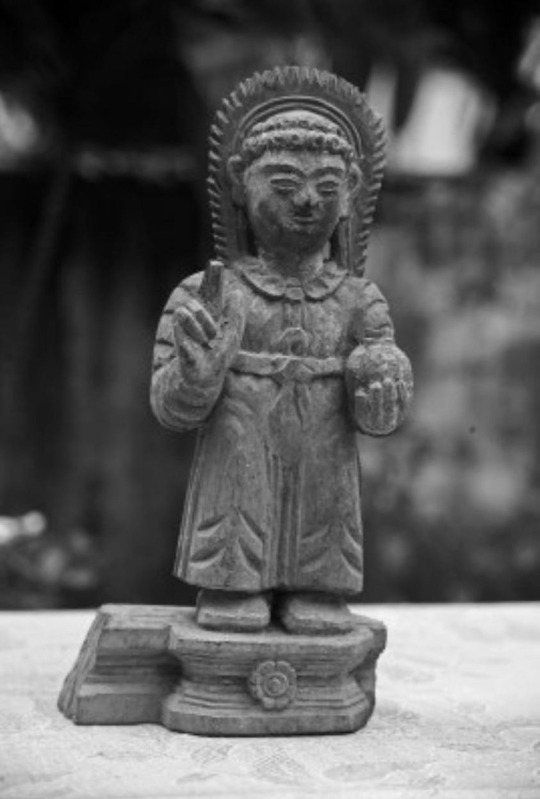
+++
This fascinating small statue is mentioned briefly in a 2018 book by Dr. Istvan Perczel:
Here's the full page from the book (title not given):

+++
The other commentary in this post is summarized from a Reddit post (numerous writers) found at https://www.reddit.com/r/Kerala/comments/18nf0eh/native_statue_of_jesus_kerala_late_16thearly_17th/?rdt=54167
Recently saw this in a work published by Dr. Istvan Perczel, a leading scholar on the Kerala Syrian Christian community. This is an extremely rare find, as much of native Kerala Christian art was either altered/destroyed or later highly influenced by the arrival of the Portuguese. This work seems to date to a unique transitional period: The Portuguese had only been in Kerala for a few decades, so elements of Native Kerala Syrian Christian culture is still present.
Dr. Perczel noted that the work shows heavy influence from Buddhism and Hinduism, as Christ is modeled off of Buddha and is standing on a lotus flower similar to Hindu Gods and Goddesses. At the same time, he uniquely stated that the statue shows elements of Egyptian culture as well, as the belt of Jesus is tied like the hieroglyphic Ankh sign. According to Dr. Perczel, several local statues around this era or before show similar Egyptian influence, suggesting a relic from Kerala’s ancient trade with the Red Sea.
This Jesus is "child jesus" and hence no beard. Popularly known in malayalam as "unni eesho". The globe in hand denotes infant Jesus. A flaming nimbus is behind his head.
This was made during the late 16th/early 17th century. The Portuguese had began to Latinize the Nasrani Community but not fully so. For the first time the community began making statues (a Latin Catholic custom) as before this era, they did not believe in the creation of idols (due to being East Syriac Christians).
The artist who made this, is very clearly trying to recreate Infant Jesus (a historic and extremely common European statue of Jesus in his youth). The Syrian Christian artist or patrons, had no idea how to depict a Christian statue, because they had never done so up to this point. For that reason they mimicked the statues of Hindu Gods and traditional Kerala artistry while incorporating a very clear reference the famous “Infant Jesus” statue.
+++
Dr. Istvan Perczel is a renowned scholar from Hungary. Read about part of his research on Indian Syrian Christians at https://people.ceu.edu/istvan_perczel and https://www.mgu.ac.in/istvan-perczel-appointed-as-mar-chrysostom-chair-at-m-g-university/
1 note
·
View note
Photo


I’m a little late; I first heard about Bishop Jacob Mar Barnabas in May of last year; I heard a little bit about his ministry and his dedication to the poor, and also that he was among those affected by the deadly wave of coronavirus that was spreading in India at that time; he was already on a ventilator at the time. For the next couple months after, I’d occasionally try to learn more about his situation, but I was coming up empty on English news sources. Well, I just looked again, and it seems his excellency had died back in August. Please keep him in your prayer, and remember his motto:
Vachanasya Sakshi Bhava Be a witness to the Word
5 notes
·
View notes
Text
To clarify, most of Europe voluntarily converted to Christianity without any imperialism, so no holidays were stolen, just modified to fit the new religious paradigm.
In fact, Christianity spread throughout much of the world without imperialist violence. The Ethiopian Orthodox church and the Nasranis of India predate the widespread adoption of Christianity in Europe. Several Mongolian steppe tribes converted to Nestorian Christianity as a less abstentious alternative to Islam. The first Bible to arrive in Japan was a Chinese translation brought by merchants.
Large-scale Christian imperialism was only really practiced in the early modern colonization of the Americas, Australia, and Polynesia. European "pagans" don't get to appropriate their trauma.
This is your reminder that "New Age" is not a catch-all term for "modern spiritual practices I find shallow and annoying."
New Age is a specific form of spirituality centered around the belief that the Earth is about to enter a new cosmic cycle. Its mythology is mostly just a bunch of far right conspiracy theories in a spiritual hat. They believe in hyperdiffusionism, the ancient astronaut hypothesis, and some form of nearly every antisemitic trope in the book.
A lot of people who use the term "New Age" as a blanket term against people they find annoying or shallow are just as bad, believing in many of the same conspiracy theories and engaging in other forms of appropriation and/or erasure. (This is a major problem in Solomonic magic.) A bunch of people believe that Christian holidays were stolen from pagan ones, little realizing how much of this goes back to Alexander Hislop, a conspiracy theorist.
New Age isn't just a bunch of annoying white people appropriating Indigenous spirituality or practicing crystal healing or whatever. It's far more harmful than most people realize, and people are far more likely to share in its beliefs than they realize.
807 notes
·
View notes
Text
Lmao about naming conventions. Imagine deciding not to be catholic and then trying to choose a trans name while trying to do a throwback to your mallu heritage
#i'd be a first son but dad also threw a wrench in our last name when he immigrated here#gonna apropriate my own family ig#they would hate me culturally but well. nof planning on going to christian heaven or hell so i doubt i'll be meeting them (:#anyway kuriakose is totes american right#literally only now learning what nasrani means
0 notes
Photo

#shoottime #canon📷 #photooftheday #photographylover #canon6dmarkii #nasranistories #nasrani #christianity #achayathi #achayathis #chattayummundum https://www.instagram.com/p/B-r2Zn2jW-j/?igshid=q34326ozjwho
#shoottime#canon📷#photooftheday#photographylover#canon6dmarkii#nasranistories#nasrani#christianity#achayathi#achayathis#chattayummundum
0 notes
Note
Small correction:
In Arabic, Christians are called "masihiyyun". It's a term both Christians and Muslims use to refer to Christians. I'm not really sure if "nasrani" in Arabic is a neutral term, as I'm not an Arabic-speaker. I know that St Thomas Christians in India, a community of Indians that were converted in the first century, refer to themselves as "nasrani", which comes from the Syriac word for Christian.
+ While most Iraqi Christians are indeed ethnic Assyrians, not all of them are! There are Iraqi Christians who are ethnic Arabs, too, and there are even some small minorities of Iraqi Christians who are ethnic Turkmens. It's very important to use the term "Iraqi / Middle Eastern Christian" in this context, because ISIS did not persecute these people for their ethnicities, but for their Christian religion. Also, it just makes me so angry when Spanish Christians act as though they have anything in common with Christians in the Middle East when it comes to marginalisation and persecution! That's why I don't trust anyone with a ن in their bio when they belong to a Christian group that historically has always been privileged.
Both masīhīun (مسيحي) meaning "followers of the Messiah" and naṣrānīun (نصراني) meaning "Nazarene" mean Christian in Arabic and Persian (but the second one in Persian is nasrānī). It's true as you say that masīhī is how Christians who speak Arabic call themselves, but naṣrānī is still common and has a broader cultural meaning (not just strictly religious like masīhī). I don't know either if it's negative, I've heard that naṣrānī is a pejorative word for Christians but I didn't say that in the original post because personally I've heard it in specific contexts where it was pejorative but I don't know enough to say for sure how general that is, so I'd rather not make a statement I'm not sure of.
If any Arabic speaker wants to comment and solve our doubt, feel free to do so and I'll be thankful!
And about the Spanish Catholics, exactly my thoughts. It's not only that they've been and are privileged but that the Catholic power been extremely cruel in Spain until very very recently.
33 notes
·
View notes
Text
"Western religion" *Laughs in nasrani* But, this is interesting. What's with Be On Cloud and Mary? I thought seemingly random Marian imagery in KinnPorsche was to invoke innocence, initiation rites, and involvement in crime as with the Sicilian mafia, the Calabrian ‘ndrangheta and the Neapolitan camorra. But then Color Rush season 1 showed "The Virgin in Prayer" to discuss blue (ultramarine and lapis lazuli), iirc.
We had lots of fun referring to Mary in BL: "BL പരമ്പര മാതാവ് " - a wordplay on പരമ്പര which also means series. *Giggles in Suriyani Malayalam*
Now, I am curious about catholicism and Christianity in general in Thailand. And colonialism in Thailand. I mean, even though they didn't have Western colonialism, they faced Japanese imperialism. Thailand also underwent "Westernization". Plus, Thaification - which is an ongoing process (I don't know if it is fair to call that "colonialism").
On today's "I am SO not normal about Dead Friend Forever": Discussing Catholicism and Colonization in this gay Thai slasher series
Some background on me: I am from a Latine Catholic family. Raised as a non-practicing Catholic (we didn't go to church or pray). Then my parents enrolled me in a Catholic school that I attended from 5th grade to the end of 7th grade. Today, I am not Catholic and have never really considered myself as such.
Ok, so in the flashback episodes of DFF, I have been noticing a lot of things. My findings under the cut.
Let's start with this crucifix and photo of the Virgin Mary and a baby Jesus.
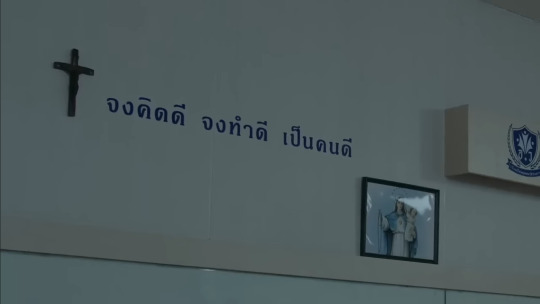

Screenshot from ep. 5.
The camera lingers here a bit so we're obviously meant to pay attention to the phrase. I put the screenshot through Google translate's image translator and the translation it gave me was, "Think good, do good, be a good person." I didn't think much of it when I first watched the episode other than it was supposed to establish that the boys attend a Christian or Catholic school.
But then there was this image posted on Be On Cloud's Instagram (also from ep. 5): X
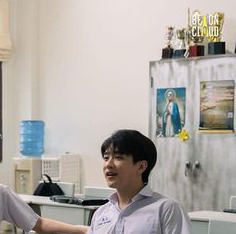
Zooming in, we can see there's another picture of Mary in the background. Watching the classroom scenes, it's easy to miss because the series itself is more washed out than the official photos posted. But this emphasis on Mary led me to believe the school is a Catholic one. So out of curiosity, I looked up the schools the writers and directors attended because I felt I was onto something here. And boy, was I!

Source: MDL
Ma-Deaw, if you didn't know, is one of the directors of Dead Friend Forever (he also directed Manner of Death and Inhuman Kiss , and lots of other things).
One Google search later (X) and I learned "Montfort College" is a Catholic school. It started out as a primary school that later added a secondary school as well.
Now let's take a closer look at some of the details of this school:
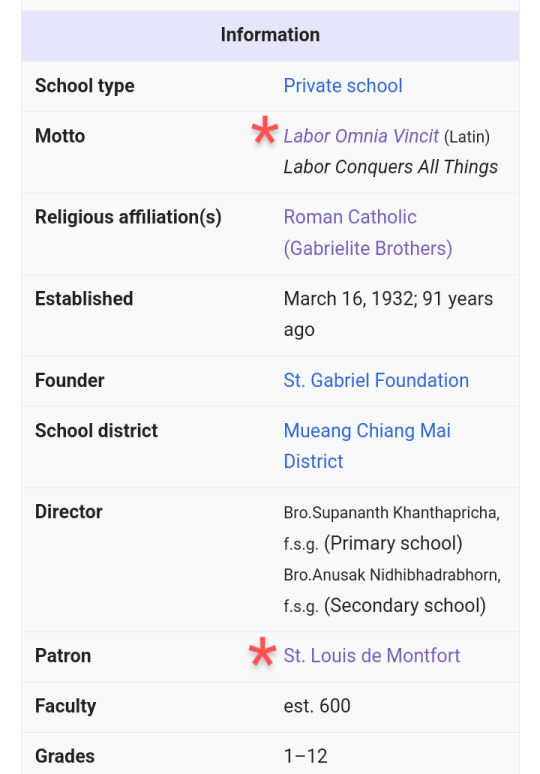
First, the school's motto "Labor Conquers All Things". This reminded me of the phone conversation Tee had with his uncle:
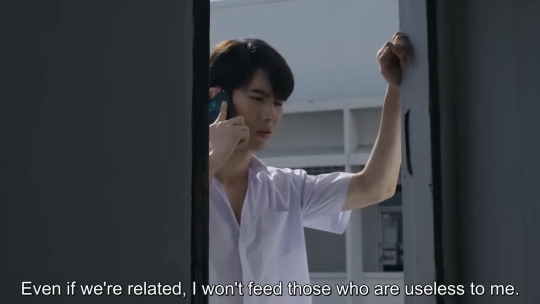
On my first watch, this sounded familiar to me but I couldn't really place why. It wasn't until I saw this other Tumblr post (X) that pointed out it's similar to a bible quote from the New Testament. The quote varies a bit depending on which version of the bible you're using but it's along the lines of, "He who does not work, neither shall he eat".
This is meant to discourage "laziness". Nevermind the fact that people deserve to eat simply because we get hungry and need food to survive. The idea that we only "deserve" things based on productivity is an extremely colonial one. — Reminder also that Tee is being forced into this "work" in the first place. He's just a high school kid. I don't need to like his character to understand how fucked up his situation is.
Then there's the patron of the school. St. Louis de Montfort was a French Catholic priest most known for his study in Mariology. What is Mariology (X)? The study of Mary, the mother of Jesus. I didn't know that was a thing but it's unsurprising considering how prominent images of Mary were in my own religious upbringing. And she's what started me down this rabbit hole in the first place. Mary is a big deal to the Catholics. I'm going to be paying even more attention now if more Mary imagery pops up.
The Garden of Eden and Original Sin
Now I want to draw attention to these images:

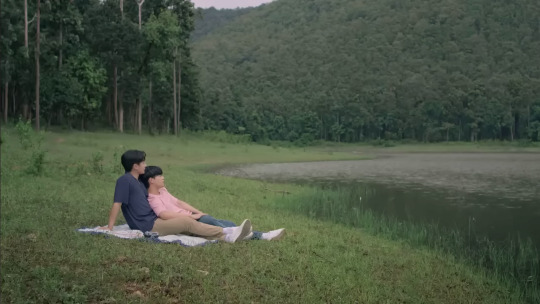
Screenshots from ep. 7
Here we have Non and Phee biting into an apple as they leisure around this lush green field. We know they've visited this location more than once because they're wearing different outfits in the screenshots. And I think it's important to note that it's Phee holding the apple and offering it to Non.

The use of the word "bait" in the bts of ep. 7 is quite interesting too. (X)
The Garden of Eden was the paradise in which Adam and Eve resided. In this garden, there were many trees to eat from. The one tree Adam and Eve were forbidden by God to eat from was the Tree of Knowledge. A serpent (Satan), first tempted Eve into taking from the tree to eat it's fruit. And then Eve gave the fruit to Adam. That is Original Sin. And because Adam and Eve ate from the Tree of Knowledge, all humans thereafter are born sinful and bad, and can only find salvation through God.
Of course in the scene between Phee and Non, the sin the apple represents is being gay. And it's after this, and after the bracelet scene, that Non becomes involved with Por's film and his tragedy begins.
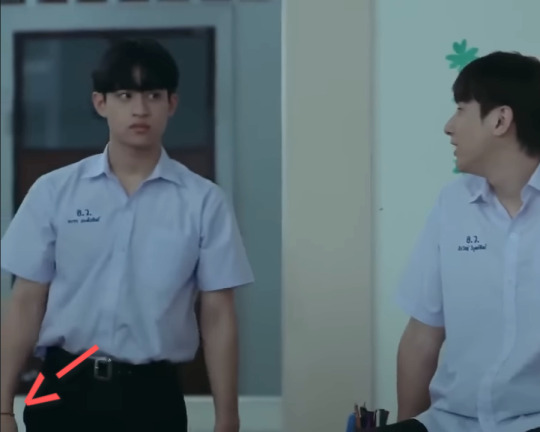
Zoomed in screenshot from ep. 5
And I wonder if the bracelet scene is the last time Phee and Non visit this forest location. It would parallel how Adam and Eve were cast out of the Garden of Eden once they sinned.
Final Thoughts
You give me a story that criticizes Western religion and how it's used as a tool for oppression and colonization, and I'm gonna eat that shit up. I am gonna eat it up. Every. Single. Time.
I really wasn't expecting anything like this from Dead Friend Forever. This level in attention to detail is unmatched. I don't think I've watched a more well planned out show. And no matter where DFF goes from here, these seven episodes will always hold a special place in my heart. 💗
#christianity#thai bl#boys love#yaoi#yaoi bl#asianlgbtqdramas#asian lgbtq dramas#asian bl series#thai series#thailand#catholiscism#christianity in bl#religion in bl
197 notes
·
View notes
Text
reading about the goan inquisition and -
The Inquisition was established by the colonial era Inquisition in Portuguese India to enforce Catholic orthodoxy in the Indian colonies of the Portuguese Empire,[1] and to counter the New Christians, who were accused of "crypto-Hinduism", and the Old Christian Nasranis, accused of "Judaising".[1] It was established in 1560, briefly suppressed from 1774 to 1778, continued thereafter until finally abolished in 1812.[2][3] The Inquisition punished those who had converted to Catholicism but were suspected by Jesuit clergy of practising their previous religion in secret. Predominantly, those targeted were accused of Crypto-Hinduism.[4][5][6] Many criminally-charged natives were imprisoned, publicly flogged and, dependent on the criminal charge, sentenced to death.[7][8] The Inquisitors also seized and burnt any books written in Sanskrit, Dutch, English, or Konkani, on the suspicions that they contain deviationist or Protestant material.[9]
New laws promulgated between 1566 and 1576 prohibited Hindus from repairing any damaged temples or constructing new ones.[70] Ceremonies including public Hindu weddings were banned.[61] Anyone who owned an image of a Hindu god or goddess was deemed a criminal.[70] Non-Hindus in Goa were encouraged to identify and report anyone who owned images of god or goddess to the Inquisition authorities. Those accused were searched and if any evidence was found, such "idol owning" Hindus were arrested and they lost their property. Half of the seized property went as reward to the accusers, the other half to the church.[70]
Hindus were forbidden from occupying any public office, and only a Christian could hold such an office;[47][48]
Hindus were forbidden from producing any Christian devotional objects or symbols;[47]
Hindu children whose father had died were required to be handed over to the Jesuits for conversion to Christianity;[47] This began under a 1559 royal order from Portugal, whereafter Hindu children alleged to be orphan were seized by the Jesuits and converted to Christianity.[48] This law was enforced on children even if mother was still alive, in some cases even if the father was alive. The parental property was also seized when the Hindu child was seized. In some cases, states Lauren Benton, the Portuguese authorities extorted money for the "return of the orphans".[48]
The Catholic missionaries aimed to eradicate indigenous languages such as Konkani and cultural practices such as ceremonies, fasts, growing of the tulsi plant in front of the house, the use of flowers and leaves for ceremony or ornament.[84]
30 notes
·
View notes
Text
reaffirming my ❤️ for മലയാളം
1. A Palindrome
Malayalam is perhaps the world’s only language that is a palindrome when written in English.
The word Malayalam is a combination of 2 words – ‘Mala’ meaning ‘mountain’ and ‘Alam’ meaning ‘region’. Thus the word literally means ‘the mountain region’.
The term originally refers to the land under the Chera dynasty. Later on, it became the name of the region’s language.
Until the 16th century, Malayalam, referred to by several other closely related names, including Malayanma and Malayalama.
2. A classical language with origins in Tamil
The popularly held opinion is that the Malayalam language evolved from Middle Tamil between the 9th and 13th centuries. Until then it was a western coastal dialect of Tamil.
However, there is also a contrary view that Malayalam did not originate from Tamil. Rather, both Malayalam and Tamil evolved from a common ancestor known as ‘Proto Tamil-Malayalam’.
‘Manipravalam’ was a macaronic language used in certain Malayalam language texts before it established its modern form in the 16th century. It was a combination of Tamil and Sanskrit.
The Manipravalam language and its script influence the modern form of the language greatly, so much so that Malayalam continues to be the one Dravidian language with extensive Sanskrit influence.
In 2013 Malayalam accorded the status of classical language by the Government of India.
3. Malayalam has some of the most complicated alphabets
Written in the Brahmic script, Malayalam has 15 vowels, 42 consonants, and certain other symbols. In fact, the language has some of the most specific and complicated sounds represented in letters. Equivalent differences hardly exist in other Indian languages.
There are 2 separate alphabets to denote the sound ‘r’- one for ‘r’ (ര) as in Spanish tres and the other for ‘ṟ’ (റ) as in Spanish Rojo. Equivalent pronunciation differences do not exist in English or Hindi.
Malayalam also has the alphabet ‘ഴ’(zha) which pronounced like the rhotic r as in ‘purse’ in English. This rhotic consonant is absent in almost all other Indian languages.
There are 2 separate consonants for the sound ‘l’ – one for ‘l’ (ല) as in ‘language’ and the other for ḷ (ള ) as in ‘plumber’.
4. Distinct nasal tones
Nasal sounds form an indispensable part of the spoken form of the Malayalam language.
The most basic pronoun ‘me’ is a nasal tone, pronounced as ‘ñaan’, where the ‘ña’ sounds like the NY in ‘canyon’. So is the nasal sound ‘ng’ as in ‘sing’ used extensively.
Several words that may have equivalent forms in other Indian languages like Hindi, take on a nasal tone in pronunciation in Malayalam.
For example in the Hindi word ‘Sundar’, the d sound distinctly pronounced in the NDA cluster.
However, in the equivalent Malayalam word ‘Sundaram’, the d sound becomes silent in the NDA cluster and instead pronounced as ‘sunnaram’, producing a distinct nasal tone in its place.
5. The Malayalam script was literally and figuratively ‘moulded’ for the printing press
The original Malayalam script that began as what is called the Vattelettu, has undergone significant changes. These changes made so as to accommodate the needs of making moulds for the printing press.
Until Benjamin Bailey, a British missionary brought the printing press to Kerala, Malayalam was written and printed in the Grantha script with square type fonts.
In 1829, Bailey ushered in a momentous change in the history of Malayalam by replacing these with the round script that is used to date.
The script from Bailey underwent further changes as the needs of the press changed. Local newspapers like the Malayala Manorama have done significant changes in the script.
6. The European hand in Malayalam
Not just Benjamin Bailey, several Europeans have had a decisive role in the development of the modern form of Malayalam language.
The first book to have Malayalam script printed in it was the Hortus Malabaricus, written in Latin by Henrik Van Rheede, the Governor of Dutch Malabar in 1678.
First Malayalam book Sampkshepa Vedartham which came out in 1772 didn’t publish anywhere in India but in Rome!
The first dictionary in Malayalam compiled by German scholar Herman Gundert. He has also extensively written about and codified Malayalam grammar.
7. Malayalam was written in multiple scripts by different communities
Before the evolution of the modern script, different communities in Kerala adopted Malayalam into the script of their liturgical languages.
Arabi-Malayalam is a script still in limited use among the Muslim community of Kerala. It is a variant form of the Arabic script used to write Malayalam.
Suriyani Malayalam or Syriac Malayalam was a script in popular use among the Saint Thomas Christians of Kerala, also known as the Nasranis. Malayalam, adopted into the Syriac alphabet with certain additional orthographic changes.
8. Distinct Dialects
Though not as many dialects as other Dravidian languages like Tamil, significant variations exist in spoken Malayalam.
The Dravidian encyclopedia enlists regional dialects of Malayalam into 13 dialect areas.
Caste and communal dialects are visible in Malayalam. The spoken form of Malayalam among the Mappila Muslims of Kerala has considerable influence on Arabic and Persian. Portuguese, Greek, and Syriac words find their way into certain dialects spoken by Christian communities.
While Hebrew, Syriac, and Ladino were dominant in Judeo Malayalam- a dialect spoken by the Cochin Jews who are virtually non-existent now in Kerala.
Jeseri and Byaare are 2 dialects of Malayalam that are extremely divergent from the Malayalam spoken in mainland Kerala.
While Jeseri is spoken in Lakshadweep, Byaare is spoken in Northern Kerala and Southern Karnataka.
9. A plethora of Loan Words
Malayalam is heavily influenced by several other languages that it consists of too many loan words.
These loan words that have come from languages like Portuguese, Dutch, and Arabichave become so ingrained into the everyday usage of Malayalam.
Common words in Malayalam for chair (kasera), table (mesha), pen (pena), paper (kadalas) and window (janala) all come from the Portuguese words cadeira, mesa, pena, cartez, and Janela respectively.
Malayalam has also given loanwords to Portuguese. The Portuguese words for jackfruit (jaca), teak (teca), and jaggery (jagra) have its origins in the Malayalam words chakka, thekku, and chakkara respectively.
In fact, the very word for toilet in Malayalam, ‘kakkoos’ comes from the Dutch ‘kakhuis’!
Arabic and Persian influences also abound in the language.
10. ‘New Gen’ slang words
Thanks to Malayali youngsters, the language now has a repository of ‘new gen’ words. These are existing Malayalam words that have taken on completely new meanings and connotations according to the changing times.
Social media and movies have boosted the popularity of these new words.
‘Thallu’ which originally means ‘to push’ is one of the most popular ‘new-gen’ slang. Thallu now refers to any statement that comes off as boasting.
‘Theppu’ is another latest addition which means ‘to ditch’ a lover. However, the word originally means ‘to iron something’.
‘Pani Kitti’ is a phrase that popularly meant ‘got a job’ until a few years back. But now it means that you’ve landed up in trouble!
The Malayalam language is as interesting and versatile as Kerala. Cultural transactions with a plethora of communities from across the world have shaped the language.
In a constant state of evolution, the next time you explore the language, Malayalam will have added a whole new set of quirky facts to itself!
41 notes
·
View notes